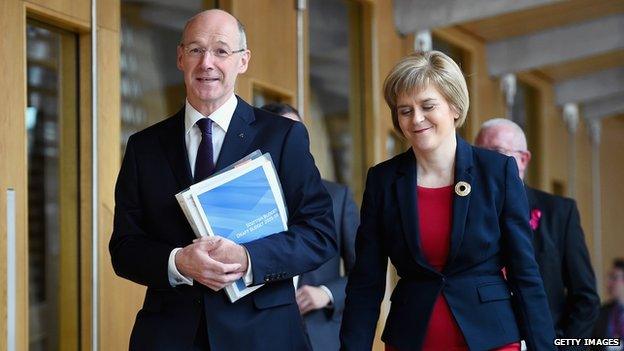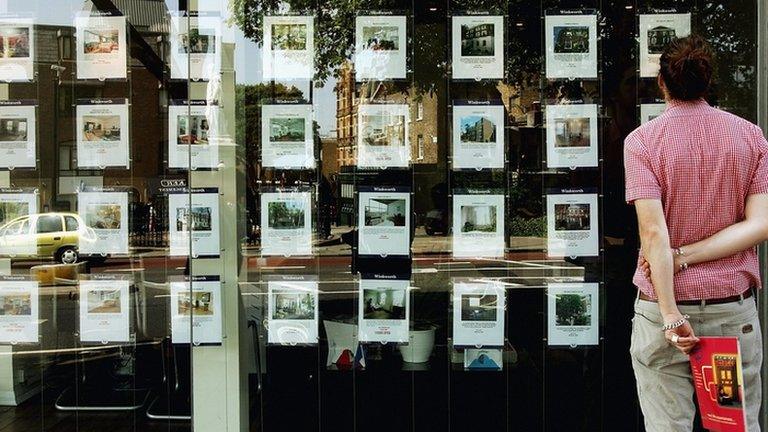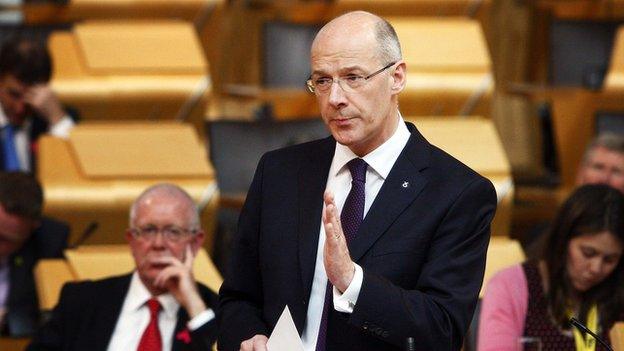Taxes come home to Holyrood
- Published

Businesses will trying to pick up clues as to what direction taxation will take as more powers are devolved
Remember the referendum campaign? Well, you'll probably also remember the warning that taxes are a volatile way of funding services.
That argument was mainly about offshore oil and gas tax, which is the most volatile of government funding sources.
But with the arrival of more modest tax powers at Holyrood with today's draft budget, MSPs are now required to develop a novel skill - handling the new uncertainty about how much money the new body called Revenue Scotland will collect.
This is obvious when you think about it: the link between tax-raising and tax-spending, and the realisation that has been absent from Holyrood thinking, that balancing the books involves more than one side of the ledger. But the implications are profound.
The totals expected to come from the taxes are revenue neutral. That is, they should raise the same amount as they would if a Scottish share of the UK taxes were still to apply after next April.
In future, that may change. John Swinney and his successors could cut tax rates to more competitive levels, to stimulate business and grow the economy. If they get lucky, it may grow so much that the tax revenue actually grows from a lower rate - the so-called Laffer Curve Effect.

John Swinney said 90% of home buyers would be better off under the new system
But for now, the choice has been to redistribute the way that taxes apply. That's most obvious on home transactions, where a home changing hands for less than £324,300 will pay less Land and Buildings Transaction Tax (LBTT) than they are currently having to pay for the UK Treasury's Stamp Duty. On sales above that level, the rates go up quite steeply.
The average such transaction during summer was £162,000, so this looks like an attractive deal for the vast majority of people. And the message is clear - the better off can expect to pay more. For the small number of transactions around the £1m mark, the tax is rising from £40,000 to £77,300.
Hated tax
That fits with the message of improved social justice that was trumpeted by many of those campaigning for independence over recent months. And for those who have been dismayed at the extension of the council tax freeze and of free provision of public services being of most advantage to the middle class, it's one way that better off people will contribute more, even if non-home owners don't get to benefit at all.
The eighth year of that council tax freeze, incidentally, is seen by the Scottish government as more helpful to poorer households, but only when measured as a proportion of their income. That is, if they avoid eight increases of 2% per year, then that is proportionately more helpful to them than the savings would be to the income of a high earner. But of course, the avoidance of 2% per year on the top banding is a much bigger giveaway to those in the big houses.

John Swinney says the new taxation system will help those on the lower rungs of the housing ladder
And according to the Scottish Trades Union Congress, it continues to hit local government spending, and at a time when the draft budget is already eye-wateringly tight for council finance chiefs. The council tax used to be 'hated', according to Alex Salmond. So the STUC would like his successor to lead an all-party review, starting with fairer council tax banding and moving on to a broader review.
It might also wish to revalue properties, to update a system which is stuck in 1991 values. But there lies a political minefield. Don't be surprised if the main parties refuse to take up the STUC's proposal.
Slab effect
One part of the new LBTT that is surely universally welcome is that it ends the Stamp Duty's cliff edge rates. Instead of paying a higher percentage of the full value of your house transaction when it goes through one of the Treasury's threshholds - the 'slab effect' - the Scottish tax rate starts being applied to the start of that higher tranche.
It's a marginal rate, and therefore we get away from the worst of the distorting effects on house prices as buyers bunch their prices below the threshholds.
A similar move to redistribute from the big fish to the small is being made on non-residential LBTT. Small businesses buying a shop, for instance, can save a bit.
But big business will pay quite a lot more. Commercial property experts CBRE say it's not such a penalty that it's likely to distort investment decisions, but business is watching these budget signals, and will make its own judgements on the direction of tax if/when Holyrood gets more taxation powers.
Unpredictable
But back to where I started out - on the question of volatility. Stamp Duty fell very sharply at the start of the financial crunch, because the number of property market transactions roughly halved. Mr Swinney will hope that isn't repeated with his new taxes, because that would - obviously - knock his budget out of kilter.
The main taxes already controlled at Holyrood - council tax and business rates - are relatively predictable, in that they're levied on property which is immoveable, easy to identify and easy to collect. Home ownership transactions are easy to identify, but it's harder to predict how many of them there will be.
And that's one reason why the Scottish government has set up the Scottish Fiscal Commission (SFC) under the chairmanship of banker Lady Susan Rice. It produced its first report today.
This has a role similar to at least part of what the Office for Budget Responsibility does for Whitehall - independently setting out forecasts and commenting on the reliability of government assumptions. The SFC's report emphasises just how little is known about the behaviour of Scots as new taxes and tax rates are applied, and it says there should be a high priority applied to getting more reliable data.
To illustrate the uncertainty, on the Scottish Landfill Tax, the intention is partly to raise funds, but it's also to change behaviour of dumpers over the next 10 years. If it's more successful than anticipated in its environmental impact, it may cause a modest amount of headache in revenue-raising. And it turns out, from the SFC report, that the Scottish government's estimates are based on rifling through our rubbish to see how our behaviour is changing so far.
Watchdog
The one criticism that the SFC levels at the Scottish government's tax-raising assumptions is about a tax power it has controlled for 15 years. Business rates are worth north of £2bn to Holyrood and council budgets.
The take rises because inflationary increases are applied, and painfully so for some struggling businesses. Then there's the additional tax take as new offices, factories and warehouses are built or upgraded.
The SFC has warned that the estimates of that increase in the business footprint are "on the optimistic side", in that the Scottish government is assuming a buoyancy higher than anything that's been seen before, rather than relying on average increases.
Taken over time, that could leave a growing gap between anticipated tax take and the out-turn. And as the commercial property market is highly susceptible to swings in the economic cycle, that's one area of vulnerability.
Having gained these taxes, it's a reminder for the Scottish government that independent watchdogs sometimes bark.
- Published9 October 2014

- Published9 October 2014

- Published9 October 2014
